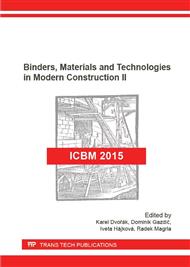[1]
C. Li, H. Sun, L. Li: A review: The comparison between alkali-activated slag (Ca+Si) and metakaolin (Si+Al) cements. Cement and Concrete Research Vol. 40. (2010), pp.1341-1349.
DOI: 10.1016/j.cemconres.2010.03.020
Google Scholar
[2]
J. Koňařík: Influence of activator on the basic properties of alkali activated systems. Bachelor thesis, FAST, VŠB-TUO, Ostrava (2014) 72 p.
Google Scholar
[3]
J. Koňařík: Testing of alkali activated systems based on blast furnace slag and evaluation of the usability in a selected field of construction. Diploma thesis, FAST, VŠB-TUO Ostrava (2015) 72 p.
Google Scholar
[4]
P. Mec, J. Boháčová, J. Koňařík, P. Závrský: Alkali activation of blast furnace slag by various types of activators, Solid State Phenomena, ISSN: 1662-9779, Vol. 244, pp.94-101.
DOI: 10.4028/www.scientific.net/ssp.244.94
Google Scholar
[5]
J. Provis, J. S. Van Deventer: Geopolymers: structure, processing, properties and industrial applications. Boca Raton, FL: CRC Press, (2009) 454 p. Woodhead Publishing in materials. ISBN 14-398-0970-4.
Google Scholar
[6]
V. Václavík, V. Dirner, T. Dvorský, et al.: The use of blast furnace slag. Metalurgija, Vol. 51 Issue: 4 (2012) p.461 – 464.
Google Scholar
[7]
S. Shi, A. F. Jimanéz, A. Palomo: New cements for the 21st century: The pursuit of an alternative to Portland cement. Cement and Concrete Research. Vol. 41, Issue 7, July (2011) pp.750-763, ISSN 00088846.
DOI: 10.1016/j.cemconres.2011.03.016
Google Scholar
[8]
C. Shi, P. V. Krivenko, D. Roy: Alkali-activated cements and concretes. Taylor&Francis, Oxford, (2006).
DOI: 10.4324/9780203390672
Google Scholar
[9]
J. Davidovits: Geopolymer: chemistry and applications. 3rd ed. Saint-Quentin: Institut Géopolymère, (2011) 610 p., ISBN 978-295-1482-050.
Google Scholar
[10]
ČSN EN 196-1. Methods of testing cement - Part 1: Determination of strength. Czech Standardisation Institute (2005).
Google Scholar
[11]
ČSN EN 15167-1. Ground granulated blast furnace slag for use in concrete, mortar and grout - Part 1: Definitions, specifications and conformity criteria, Czech Standardisation Institute (2006).
DOI: 10.3403/30130594u
Google Scholar
[12]
ČSN EN 933-1. Tests for geometrical properties of aggregates - Part 1: Determination of particle size distribution - Sieving method, Czech Standardisation Institute (1999).
DOI: 10.3403/01236185
Google Scholar
[13]
Czech Development Agency, o. p. s.: Current state of research in the field geopolymer. (2005) 181 p.
Google Scholar


